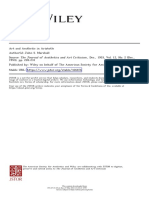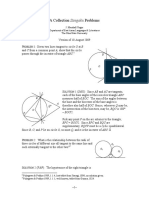0 ratings0% found this document useful (0 votes)
47 viewsRTX 100100008 P
RTX 100100008 P
Uploaded by
Abha SrivastavaMathematics sits between art and science, containing elements of both. Mathematicians strive for both beauty and truth in their work, guided by aesthetic judgment to build intellectual structures that help explain the universe. While science deals with facts and art is subjective, the choice of mathematical theories involves human judgment and preference for the simplest or most beautiful theories. Mathematics thus links art and science by ordering facts into elegant theories that seem to capture truths about the natural world. The article will provide examples of how beauty appears in different areas of mathematics.
Copyright:
© All Rights Reserved
Available Formats
Download as PDF, TXT or read online from Scribd
RTX 100100008 P
RTX 100100008 P
Uploaded by
Abha Srivastava0 ratings0% found this document useful (0 votes)
47 views1 pageMathematics sits between art and science, containing elements of both. Mathematicians strive for both beauty and truth in their work, guided by aesthetic judgment to build intellectual structures that help explain the universe. While science deals with facts and art is subjective, the choice of mathematical theories involves human judgment and preference for the simplest or most beautiful theories. Mathematics thus links art and science by ordering facts into elegant theories that seem to capture truths about the natural world. The article will provide examples of how beauty appears in different areas of mathematics.
Original Description:
rotating fluids systems
Original Title
Rtx 100100008 p
Copyright
© © All Rights Reserved
Available Formats
PDF, TXT or read online from Scribd
Share this document
Did you find this document useful?
Is this content inappropriate?
Mathematics sits between art and science, containing elements of both. Mathematicians strive for both beauty and truth in their work, guided by aesthetic judgment to build intellectual structures that help explain the universe. While science deals with facts and art is subjective, the choice of mathematical theories involves human judgment and preference for the simplest or most beautiful theories. Mathematics thus links art and science by ordering facts into elegant theories that seem to capture truths about the natural world. The article will provide examples of how beauty appears in different areas of mathematics.
Copyright:
© All Rights Reserved
Available Formats
Download as PDF, TXT or read online from Scribd
Download as pdf or txt
0 ratings0% found this document useful (0 votes)
47 views1 pageRTX 100100008 P
RTX 100100008 P
Uploaded by
Abha SrivastavaMathematics sits between art and science, containing elements of both. Mathematicians strive for both beauty and truth in their work, guided by aesthetic judgment to build intellectual structures that help explain the universe. While science deals with facts and art is subjective, the choice of mathematical theories involves human judgment and preference for the simplest or most beautiful theories. Mathematics thus links art and science by ordering facts into elegant theories that seem to capture truths about the natural world. The article will provide examples of how beauty appears in different areas of mathematics.
Copyright:
© All Rights Reserved
Available Formats
Download as PDF, TXT or read online from Scribd
Download as pdf or txt
You are on page 1of 1
The Art of Mathematics
Michael Atiyah
n the traditional dichotomy between Art and
Science, mathematics sits warily between the
two. Hermann Weyl said that, in his mathematical work, he always strived after beauty
and truth, and we might regard these as being
the contrasting characteristics of Art and Science.
Mathematicians try to understand the physical
world, to unearth the secrets of nature, to search
for truth. They do this by creating intellectual edifices of great subtlety and beauty, guided by their
aesthetic judgement. Seen this way, mathematics
links Art and Science in one great enterprise, the
human attempt to make sense of the universe.
We mathematicians can appreciate this grand
philosophical unification, but to the layman,
unversed in our secrets, Science and Art seem
diametrically opposed. Science deals with the
hard facts of existence while the Arts exist only
in the human mind; beauty lies in the eye of the
beholder. Science is objective, Art is subjective,
the two dwell in parallel planes and never meet.
This nave distinction fails to grasp the nature
of science. Poincar said that science is no more
a collection of facts than a house is a collection
of bricks. The facts have to be ordered or structured, they have to fit a theory, a construct (often
mathematical) in the human mind. The choice of
a theory is a human choice; we prefer the theory
which appeals to us best, the simplest or most
beautiful. We employ Occams razor, which tells
us to make the least assumptions. The success of
science seems to indicate that the beauty which
we humans search for in mathematical theories
does capture aspects of truth, that the universe is
indeed built on principles which harmonize with
the human mind, that in the words of Keats: Truth
is beauty, beauty truththat is all ye know on earth
and all ye need to know.
While poets have the insight to reach such an
understanding, there are few who can see how to
reconcile truth and beauty. Mathematics may be
Sir Michael Atiyah is Honorary Professor of Mathematics at the University of Edinburgh. His email address is
M.Atiyah@ed.ac.uk.
NOTICES
OF THE
art, but to the general public it is a black art, more
akin to magic and mystery. This presents a constant challenge to the mathematical community:
to explain how art fits into our subject and what
we mean by beauty.
In attempting to bridge this divide I have always
found that architecture is the best of the arts to
compare with mathematics. The analogy between
the two subjects is not hard to describe and enables abstract ideas to be exemplified by bricks
and mortar, in the spirit of the Poincar quotation
I used earlier.
In architecture one finds a variety of function
(from churches to railway stations), a variety of
materials (from bricks to glass), and beauty at all
levels (from fine detail to great vision). A mathematical theory exhibits similar variety except
that the technology is now intellectual rather than
physical and the beauty is a more difficult taste
to acquire.
Fortunately there are many detailed ways in
which art and beauty appear in mathematics, and
some of these can be appreciated by the general
public. The articles that follow will illustrate this
by many specific examples drawn from different areas and show different facets of beauty in
mathematics.
Perhaps I can end by reproducing the only
poetic passage I have ever written. It is entitled
Dreams and appears in The Unravelers,1 a book
produced by the IHES.
In the broad light of day mathematicians check their equations and their
proofs, leaving no stone unturned in
their search for rigour. But, at night,
under the full moon, they dream, they
float among the stars and wonder at
the miracle of the heavens. They are
inspired. Without dreams there is no
art, no mathematics, no life.
1 The French original Les Dchiffreurs had a French
version which some may prefer. Published by A. K. Peters.
AMS
VOLUME 57, NUMBER 1
You might also like
- Synthesis Paper On Natures Numbers by Ian Stewart 1Document8 pagesSynthesis Paper On Natures Numbers by Ian Stewart 1Keizsha L100% (4)
- Draft Project CharterDocument7 pagesDraft Project Chartercotk12100% (1)
- DCS FA-18C Hornet GuideDocument626 pagesDCS FA-18C Hornet Guidemarco100% (2)
- Asghar Qadir (رداق رغصاDocument2 pagesAsghar Qadir (رداق رغصاKhush BakhtNo ratings yet
- A Mathematicians Apology - CommentsDocument22 pagesA Mathematicians Apology - CommentskapurrrnNo ratings yet
- Truking-FD Whole SolutionDocument10 pagesTruking-FD Whole SolutionHassan AhmedNo ratings yet
- Maths. An Art, Science or ToolDocument2 pagesMaths. An Art, Science or ToolScottNo ratings yet
- Math Art PDFDocument4 pagesMath Art PDFmaleckisale100% (2)
- JShara MathsArtDocument10 pagesJShara MathsArtmd.shuraim07No ratings yet
- SPEECHDocument5 pagesSPEECHxgonticaNo ratings yet
- SPEECHDocument5 pagesSPEECHxgonticaNo ratings yet
- The Two Forms of Mathematical Beauty - Quanta MagazineDocument4 pagesThe Two Forms of Mathematical Beauty - Quanta MagazineMaría BautismalNo ratings yet
- Consider The View That Mathematics Posseses Not Only Truth, But Also Supreme BeautyDocument3 pagesConsider The View That Mathematics Posseses Not Only Truth, But Also Supreme BeautythaddeuslzyNo ratings yet
- WignerDocument9 pagesWignerDavid Greg TaylorNo ratings yet
- The Unreasonable Effectivenss of Mathematics in The Natural SciencesDocument9 pagesThe Unreasonable Effectivenss of Mathematics in The Natural SciencesMárcio DinizNo ratings yet
- Mathematical Beauty 30062011 enDocument7 pagesMathematical Beauty 30062011 enCarlocolisNo ratings yet
- SPEECHDocument6 pagesSPEECHxgonticaNo ratings yet
- Peter Galison, The Objective ImageDocument39 pagesPeter Galison, The Objective Imageakansrl100% (1)
- Mathematics, The Parsley of All SaucesDocument13 pagesMathematics, The Parsley of All SaucesScribdTranslationsNo ratings yet
- Jacques Ellul, Remarks On Technology and ArtDocument12 pagesJacques Ellul, Remarks On Technology and Artkellee0No ratings yet
- Geometry Is One and Eternal Shining in The Mind of GodDocument62 pagesGeometry Is One and Eternal Shining in The Mind of GodoscarNo ratings yet
- Math Invented or DiscoveredDocument5 pagesMath Invented or DiscoveredMike AndersonNo ratings yet
- Literature and Mathematics: An Attempt at An Inter-Thematic Analysis of Aposto/os Doxiades) Novel Uncle Petros andDocument5 pagesLiterature and Mathematics: An Attempt at An Inter-Thematic Analysis of Aposto/os Doxiades) Novel Uncle Petros andqwertimir123No ratings yet
- Musings On Quantum Music: Can Quantum Music Bring Us Closer To Objective Beauty?Document6 pagesMusings On Quantum Music: Can Quantum Music Bring Us Closer To Objective Beauty?Nondoda ChagiNo ratings yet
- Mintmade FashionDocument15 pagesMintmade FashionJack ZNo ratings yet
- The Nature of MathematicsDocument34 pagesThe Nature of MathematicsAdjha Alvaro VillaNo ratings yet
- Mathematics As A Tool To Understand and Act On RealityDocument30 pagesMathematics As A Tool To Understand and Act On RealityAngelica PantaleonNo ratings yet
- Physics Art Integration ProjectDocument15 pagesPhysics Art Integration ProjectSneha ChaudharyNo ratings yet
- Mathematics in Our WorldDocument8 pagesMathematics in Our WorldleinardNo ratings yet
- Artists and Vision ScientistsDocument27 pagesArtists and Vision ScientistsdavidrojasvNo ratings yet
- The Relationship Between Artistic Movements and Scientific DiscoveriesDocument5 pagesThe Relationship Between Artistic Movements and Scientific Discoveriespublication1No ratings yet
- Chapter 3. BeautyDocument24 pagesChapter 3. BeautyMichael Fernandez ArevaloNo ratings yet
- Untitled DocumentDocument4 pagesUntitled DocumentHenry LeongNo ratings yet
- Kumari L. A. Meera (1961-1985)Document26 pagesKumari L. A. Meera (1961-1985)api-25907247No ratings yet
- Michelangelo's Stone: An Argument Against Platonism in MathematicsDocument7 pagesMichelangelo's Stone: An Argument Against Platonism in MathematicsOlga VarelaNo ratings yet
- Mathematics A Human EndeavourDocument10 pagesMathematics A Human EndeavournavincoolguyNo ratings yet
- Art and The AestheticDocument2 pagesArt and The AestheticGargee JoseNo ratings yet
- Mathematics in The Modern World 1Document41 pagesMathematics in The Modern World 1Reyes MaritesNo ratings yet
- 22 Physics and PoetryDocument6 pages22 Physics and PoetryMônica Gonçalves Dos SantosNo ratings yet
- Essay - Art Vs ScienceDocument6 pagesEssay - Art Vs ScienceDebraj MookerjeeNo ratings yet
- QuotesDocument2 pagesQuotesSuvajit MajumderNo ratings yet
- Is God a MathematicianDocument11 pagesIs God a Mathematicianrettob1976No ratings yet
- 10 5923 J Ijtmp 20221202 03Document16 pages10 5923 J Ijtmp 20221202 03Raef BhatNo ratings yet
- Math - Assessment Task 1Document4 pagesMath - Assessment Task 1Mar CoNo ratings yet
- File 4Document2 pagesFile 4Mario Cuitavi MartínNo ratings yet
- Why Does Math WorkDocument5 pagesWhy Does Math WorkKartik SrinivasanNo ratings yet
- Think Maths - Stewart IanDocument5 pagesThink Maths - Stewart IanPrakhar GuptaNo ratings yet
- Numbers The Language of ScienceDocument405 pagesNumbers The Language of ScienceAnup SaravanNo ratings yet
- Synthesis Paper (Masuela, Anjelo)Document4 pagesSynthesis Paper (Masuela, Anjelo)Arvin John MasuelaNo ratings yet
- Artigo Orlando GraeffDocument16 pagesArtigo Orlando GraeffPaulaFernandesNo ratings yet
- HopeDocument4 pagesHopeEpic WinNo ratings yet
- John S. Marshall Art and Aesthetic in AristotleDocument5 pagesJohn S. Marshall Art and Aesthetic in AristotleCem BoluktasNo ratings yet
- A Plea For The Philosophy and History of Mathematics in The Liberal Arts CurriculumDocument23 pagesA Plea For The Philosophy and History of Mathematics in The Liberal Arts CurriculumKei Garcia AbarcaNo ratings yet
- Robert Le Ricolais: The Art of Structure Is Where To Put HolesDocument29 pagesRobert Le Ricolais: The Art of Structure Is Where To Put HolesFernando OchoaNo ratings yet
- Aesthetic TheoryDocument4 pagesAesthetic TheoryhishamdeansNo ratings yet
- The Romantic Machine: Utopian Science and Technology After NapoleonFrom EverandThe Romantic Machine: Utopian Science and Technology After NapoleonNo ratings yet
- Art by The Numbers - Images and Sculptures Inspired by Mathematical Principles (Stephen Ornes) (Dokumen - Tips)Document6 pagesArt by The Numbers - Images and Sculptures Inspired by Mathematical Principles (Stephen Ornes) (Dokumen - Tips)arnoldo3551No ratings yet
- Bombieri Math Truth PDFDocument82 pagesBombieri Math Truth PDFJonathan Torralba TorrónNo ratings yet
- MATHEMATICAL MILESTONES: Nature, Science, Business, Computers and Artificial IntelligenceFrom EverandMATHEMATICAL MILESTONES: Nature, Science, Business, Computers and Artificial IntelligenceNo ratings yet
- Electromagnetic Field Angular Momentum of A Charge at Rest in A Uniform Magnetic FieldDocument18 pagesElectromagnetic Field Angular Momentum of A Charge at Rest in A Uniform Magnetic FieldAbha SrivastavaNo ratings yet
- Conservative PDFDocument18 pagesConservative PDFAbha SrivastavaNo ratings yet
- Electron Take Three BDocument13 pagesElectron Take Three BAbha SrivastavaNo ratings yet
- 2.1 Inertial Frames of Reference: Inertial Frame or Inertial System. An Observer at Inertial ObserverDocument1 page2.1 Inertial Frames of Reference: Inertial Frame or Inertial System. An Observer at Inertial ObserverAbha SrivastavaNo ratings yet
- 01honors Physics - Direct and Inverse RelationshipsDocument9 pages01honors Physics - Direct and Inverse RelationshipsAbha SrivastavaNo ratings yet
- 1 Conservative Vector FieldsDocument8 pages1 Conservative Vector FieldsAbha SrivastavaNo ratings yet
- Conservative Fields: Domain D Domain EDocument5 pagesConservative Fields: Domain D Domain EAbha SrivastavaNo ratings yet
- Physics Math Models Human IntuitionDocument4 pagesPhysics Math Models Human IntuitionAbha SrivastavaNo ratings yet
- Four Expressions For Electromagnetic Field Momentum: Joseph Henry Laboratories, Princeton University, Princeton, NJ 08544Document8 pagesFour Expressions For Electromagnetic Field Momentum: Joseph Henry Laboratories, Princeton University, Princeton, NJ 08544Abha SrivastavaNo ratings yet
- Physicsinsights OrgDocument6 pagesPhysicsinsights OrgAbha SrivastavaNo ratings yet
- Conservative Forces and Scalar Potentials: Needs "Vectoranalysis'" Curl X 2, 2 Y Z, Y 2, Cartesian X, Y, ZDocument6 pagesConservative Forces and Scalar Potentials: Needs "Vectoranalysis'" Curl X 2, 2 Y Z, Y 2, Cartesian X, Y, ZAbha Srivastava100% (1)
- Upsee Medical BrochureDocument1 pageUpsee Medical BrochureAbha SrivastavaNo ratings yet
- A Collection Sangaku ProblemsDocument25 pagesA Collection Sangaku ProblemsAbha SrivastavaNo ratings yet
- Important Notice: U.P. State Entrance Examination (UPSEE) - 2016Document1 pageImportant Notice: U.P. State Entrance Examination (UPSEE) - 2016Abha SrivastavaNo ratings yet
- Designing Competency ModelDocument21 pagesDesigning Competency ModelAmisha Mehta100% (1)
- (PTE Helper) Advanced Plus 2 Reading & Listening - Student BookDocument205 pages(PTE Helper) Advanced Plus 2 Reading & Listening - Student BookHUYNH DUYNo ratings yet
- Quality Assurance PlanDocument24 pagesQuality Assurance PlanRudi Erianto100% (3)
- Osaka Tubular Technical Data SheetDocument5 pagesOsaka Tubular Technical Data SheetAbdul BasitNo ratings yet
- Games Design Fundamentals SlidesDocument44 pagesGames Design Fundamentals SlidesjaulloqueNo ratings yet
- Friction ProblemsDocument13 pagesFriction ProblemsrmleNo ratings yet
- Quality Project FinalDocument11 pagesQuality Project FinalAbhistChauhanNo ratings yet
- Declaration IELTS 1Document1 pageDeclaration IELTS 1Atin GoyalNo ratings yet
- Asme Sa 199 Grade t11 TubesDocument1 pageAsme Sa 199 Grade t11 TubesFerroPipENo ratings yet
- Sample Gas Cooler EGK 1/2: Bühler Constant Regulating SystemDocument4 pagesSample Gas Cooler EGK 1/2: Bühler Constant Regulating SystemFrank LuizNo ratings yet
- PoiunDocument3 pagesPoiunFitzgerald KeaneNo ratings yet
- Soalan Kertas 2 Pecutan Akhir Fizik SPM 2010 Set 1Document20 pagesSoalan Kertas 2 Pecutan Akhir Fizik SPM 2010 Set 1Ya NaNo ratings yet
- On-Line Mid Term Examination Semester Ii SESSION 2019/2020: LecturerDocument4 pagesOn-Line Mid Term Examination Semester Ii SESSION 2019/2020: Lecturernor asyiqinNo ratings yet
- Homework GermanDocument7 pagesHomework Germancfnr7tns100% (1)
- SubstationDocument33 pagesSubstationjogiyajee100% (1)
- Face Mask Detection Alert System Using Raspberry Pi: International Research Journal of Engineering and Technology (IRJET)Document3 pagesFace Mask Detection Alert System Using Raspberry Pi: International Research Journal of Engineering and Technology (IRJET)Rohit BagdeNo ratings yet
- CJS 310 Study and Review Guide 1 Spring 2021Document2 pagesCJS 310 Study and Review Guide 1 Spring 2021Zo. KozartNo ratings yet
- Tip Sheet Group WorkDocument4 pagesTip Sheet Group Work2301975No ratings yet
- D - Lean Leadership PDFDocument6 pagesD - Lean Leadership PDFIkramullah QureshiNo ratings yet
- UbifsDocument47 pagesUbifsSanel KoncarNo ratings yet
- IND-SAT 2020 Updates: Instructions To Candidates For Conduct of Mock Test and Ind-SAT 2020 ExaminationDocument5 pagesIND-SAT 2020 Updates: Instructions To Candidates For Conduct of Mock Test and Ind-SAT 2020 ExaminationIlham ShoyoNo ratings yet
- MA3004 Part 3: Computational Fluid Dynamics (CFD) : Martin SkoteDocument46 pagesMA3004 Part 3: Computational Fluid Dynamics (CFD) : Martin SkotedavidbehNo ratings yet
- PowerScan PBT9501 Quick Reference Guide (ENG)Document48 pagesPowerScan PBT9501 Quick Reference Guide (ENG)Алексей ХристофоровNo ratings yet
- National Officer'S Academy (Noa) SOCIOLOGY, Lecture No. 1 Course Outline As Per FPSCDocument13 pagesNational Officer'S Academy (Noa) SOCIOLOGY, Lecture No. 1 Course Outline As Per FPSCTuba Abrar100% (1)
- DCS Supercarrier Operations Guide ENDocument63 pagesDCS Supercarrier Operations Guide ENKERIMNo ratings yet
- December 2012Document50 pagesDecember 2012Jessie Bechayda100% (1)
- VTK Examples CXX Images Canny Edge Detector - Kit Ware PublicDocument4 pagesVTK Examples CXX Images Canny Edge Detector - Kit Ware PubliczadigjajaNo ratings yet







































































































